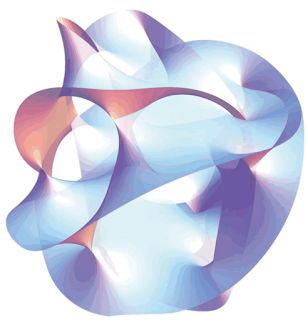String Theory Geometry
String Theory Geometry
Einstein realized that space-time was curved and so we had to move away from Euclidean geometry to analyse areas where gravitational fields were present. He used Riemannian geometry (which was already formulated) in his equations and could describe gravity using these.
Riemannian geometry breaks down when distances become shorter than the Planck length however, and so new geometry is needed for these situations. There is no ready-made tool that string theory can use unlike Einstein could do for general relativity and so a new branch of mathematics must be created along with the physics.
Riemannian Geometry
If you stand on a trampoline, your weight causes the elastic fibers to stretch and the most extreme distortion occurs right under you. This is what Riemannian geometry is all about really. It analyses the distances between locations on an object and quantifies the curvature. Increasing the stretching increases the difference from the notion of distance if the surface was flat.
Einstein gives this geometry physical meaning in general relativity. The strength of gravity dictates how much space-time curves and the curvature reflects the warped distance between two points.
The equivalence principle ensures we keep to local areas so that tidal forces decrease. The more local the area you keep to is, the weaker the tidal forces and so physics and maths align more precisely. When the area considered is a single point in space-time, maths and physics align perfectly.
String theory unfortunately does not allow the idea of points and so claims general relativity is just useful for approximations such as when analyzing galaxies are compared to the universe. In cases like this, galaxies can be modeled as points. On small scales however, this is not allowed.
The end of the universe
We know that the universe is expanding and that it seems to be accelerating due to dark energy. This may stop however if the gravitational forces in the universe can overcome dark energy. The amount of mass needed for this to happen is called the critical density of the universe. We know for sure that the visible matter in the universe is less than the critical density but dark matter may mean that the average matter density is greater than the critical density. This means the gravitational attraction will stop expansion and the universe will begin to collapse in on itself. The universe will go from billions of light years in diameter to millions of light years to the size of a single galaxy to the size of a star to the size of a planet etc.... This will continue until when? Until the universe is a point? String theory doesn't allow an arbitrarily small universe though? So what will happen?
Garden Hose Land
Point particles can move along the extended dimension or around the curled dimension or in any combination of the two. Strings can do the same but because strings arr extended objects, they have two configurations. They can move like point particles or they can wrap around the curled dimension fully and slide along the extended one.
Wrapped string have a minimum mass which is determined by the size of the circular dimension and the number of times it wraps around it. This is because the minimum length is determined by the circumference of the circular dimension and the number of times the string is wrapped around it. The the minimum length then determines the minimum mass. (Oscillations then contribute to additional mass through Einsteins mass energy relation).
Circumference ∝ Radius of curled dimension
Length ∝ Radius of curled dimension
Length ∝ Minimum mass of a string
Min Mass ∝ Radius
E = mc2
E ∝ m
Therefore for a wrapped string
Winding Energy ∝ Radius of curled dimension
The configurations of wrapped strings implies that the energy of a string comes from its vibrational motion (oscillations) and its winding energy.
Ordinary vibrations - normal oscillation of string
Uniform vibrations - sliding along extended dimension
The uncertainty principle means that uniform vibrations have energies inversely proportional to the radius of the curled dimension.
Decreasing the radius means you are more certain of position and so you must be less certain of momentum. This means velocity increases.
This means as radius decreases, the energy of motion from the string sliding increases
A large radius means a big winding mode energy but since you are unsure about position it means small vibration energy.
A small radius means small winding mode energy but since you are sure of position it mean large vibration energy.
This means for any big radius garden hose universe, there is a small radius one where
the winding mode energy of the large universe = the vibration energy of the small universe and
the vibration energy of the large universe = winding mode energy of the small universe.
The total energies in both universes would be the same and because physical properties are determined by the total energy of strings, there is no physical distinction between these two geometrically distinct universes...
Thanks for reading. If you enjoyed this post or any of my others, follow and subscribe to my blog. Feel free to discuss anything related to this post or ask questions in the comments below.
Check Out My Previous Posts On String Theory! (Link To All String Theory Posts)
Did you see my previous post? Click the link below to check it out

Comments
Post a Comment